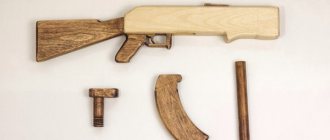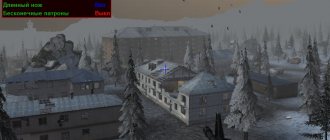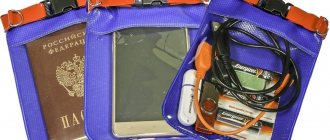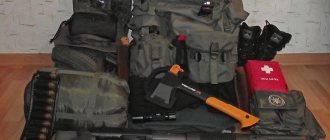When setting out on an exciting journey and getting into a positive frame of mind, the last thing you want to do is think about possible force majeure and waste time packing the equipment. Repentance comes later, when a critical situation arises, there is not a soul around, and there is no drinking water, no matches, or vital medications at hand.
In order not to add to the sad statistics and not die when finding yourself in conditions of autonomous existence, you should think through possible troubles in advance and carefully select the components of a portable emergency supply.
What is NAZ (portable emergency reserve)
In human terms, NAZ is a capsule, box or bag with “goodies” designed for survival or maximizing life extension in an extreme situation.
Some people mistakenly believe that NAZ and EDS (English Every Day Carry - “wear every day”) are the same thing. This is not true, because unlike the everyday set of EDS items, the emergency emergency supply is used exclusively for survival in an emergency situation.
As a rule, NAZ is a separately assembled minimum, consisting of tools, materials, food, medicine, etc., worn by a person in case of an emergency. You should always have a rescue kit with you, never leave it in a boat, car trunk or backpack.
On some sites for survivalists, the list of vital things somehow included: folding chairs, sets of cooking pots, and even rolls of toilet paper. So, this is not NAZ, but “something that will provide comfort during the hike.”
Remember! A wearable emergency supply is designed to support life in harsh environments, not to provide comfort.
The main meaning of NAZ
Even a healthy and physically resilient person will not last long in a forest, uninhabited island or endless steppe if NAZ is not with him. And then what can we say about a not very young traveler who is “on pills”?
Many understood the basic meaning of a life-saving kit in extremely difficult conditions, when for many kilometers there was not a soul, a shoulder bag or luggage disappeared in an unknown direction, and everything that could ensure survival was with them. The most important factors for maintaining human life include:
- Water is the most important resource, without which it is impossible to live for more than 2-4 days, and in the desert you are unlikely to survive without water for more than a few hours. The NAZ must accommodate devices for extracting, filtering, storing and transporting water. A dropper tube will help suck water out of hard-to-reach places, Aquatabs will purify the water from impurities, a condom, a plastic bag or a plastic bottle will serve as a container.
- A fire is necessary if you are spending the night outdoors or if you find yourself in harsh winter conditions. Issues such as ignition and the supply of firewood are decided before the construction of the shelter.
- Shelter for a safe overnight stay depends on the conditions in which the victim finds himself and the current time of year.
- Food is not as important as water. A person can go without food for about 2.5 weeks (if drinking water is available). In the first two days, all thoughts are only about food, but then the feeling of hunger dulls and the person enters the phase of “therapeutic fasting.”
What is NAZ?
First, let's decipher the popular abbreviation. NAZ - portable emergency reserve. The term first appeared among pilots. It was they who had to find themselves in wild territory or on enemy-controlled land in the event of a plane breakdown (or damage during combat operations). Sometimes the best tactic is to stay near the aircraft. And at other times - move away from him as far as possible. It is for such cases that a portable emergency supply is provided. On the one hand, it is quite compact. On the other hand, having it at hand, you can often survive even in circumstances that are very hostile to humans.
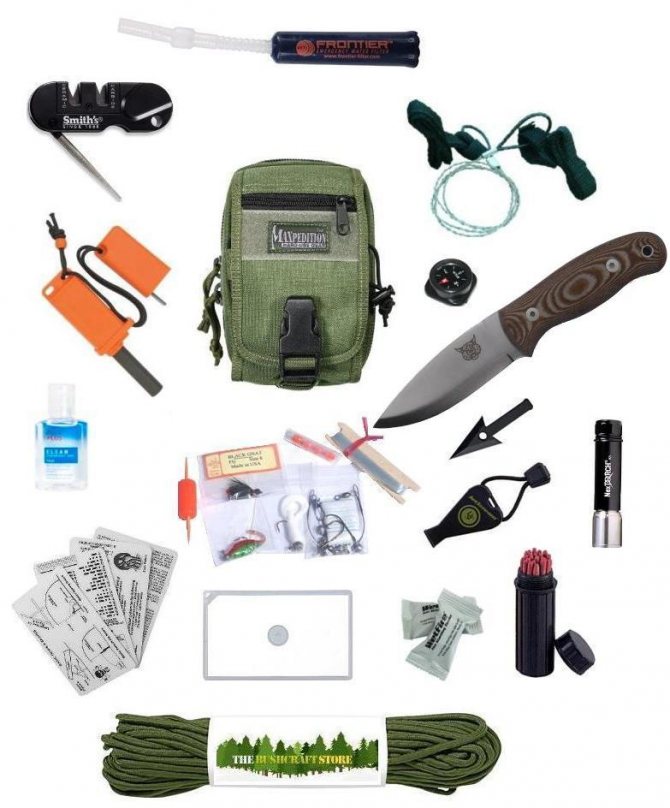
But recently the abbreviation NAZ has become popular not only among pilots. You can hear it in the conversations of many survivalists. Having such a set on hand is a rule of good form for representatives of this subculture, slightly reeking of paranoia.
The set can be very different. But it always includes items that may be needed at any time and therefore should be at hand.
NAZ contents and item descriptions
NAZ must provide a person with all of the above. But it is not for nothing that the reserve is called untouchable and is used in cases of extreme need. If you think about it, in all types of terrain, Mother Nature takes care of the “prepper.”
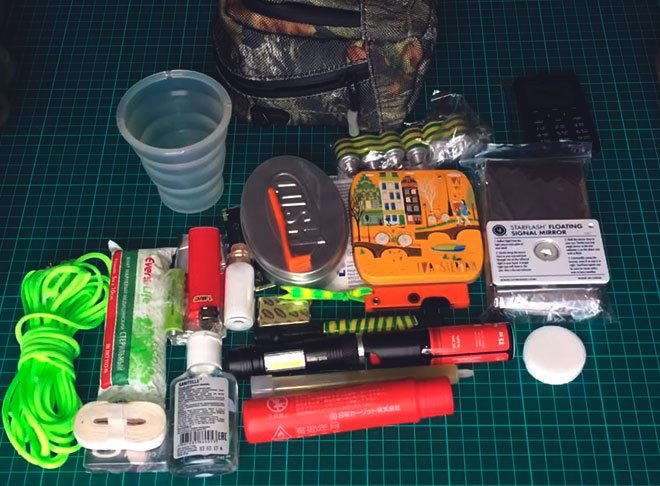
A person accustomed to living in autonomous conditions will quench his thirst from a stream, make fire using ice or a pocket mirror, and build a shelter from pine paws and other available materials.
But there are situations when a person’s life depends entirely on the contents of an inviolable capsule.
Food
Although food is not included in the NAZ minimum, always take some food with you. High-calorie food should not weigh a lot, take up a lot of space, or spoil quickly. Stuffing a snack in your jacket or pants pocket will help you satisfy your hunger on the go.
The ideal option would be:
- chocolate bars (Mars, Snickers, etc.);
- high-calorie mixtures of dried fruits and nuts;
- biscuits;
- jerky.
Note! You can pack 4 caramels into a portable emergency supply. They will not satisfy your hunger, but they will restore the loss of carbohydrates for some time.
Water
Use a condom or a pair of orange balloons as a container for storing and carrying water. You can also use balloons to signal a disaster by simply placing them on the ground.
Typical survivalist's NAZ
First, let's look at the composition of a portable emergency supply, which is most often found among ordinary survivalists who spend most of their time in large cities, in the company of people who often do not share their views.
Most newcomers try not to reinvent the wheel - why, if the military and special forces have long compiled the optimal survival kit?
Therefore, in such supplies you can often see medicines, tablets for water disinfection, a flint or magnifying glass, a survival blanket, fishing gear, chemical light sources, a small snack and much more. Most often, such a number of items takes up a considerable amount of space. To be able to carry it, many survivalists purchase a small backpack, which they fill to capacity with useful things, without which they try not to leave home. Very often there are items decorated in military style.
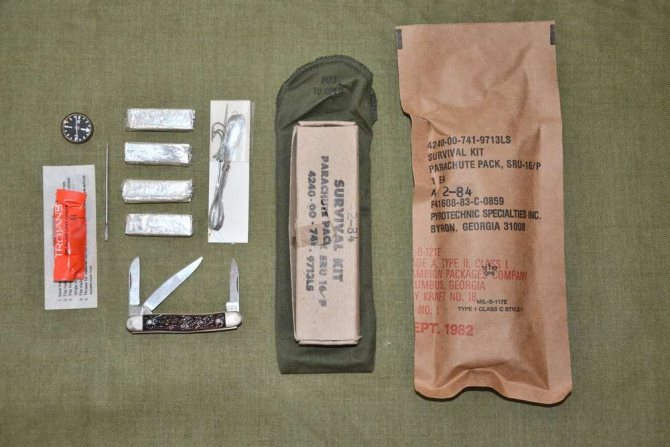
Alas, the majority do not know how to use the available items and do not even think that they simply won’t have to use most of it.
Military NAZs
In addition to water and food, military NAZs contain sources of radio communication with the center or rescuers. Their food differs from the usual tourist “snack”: glucose in the form of candies, water and salt. The military man will get the rest himself. Let's look at the rest of the set:
- Communication means - radio station, signal cartridges, light smoke bombs, mirror.
- First aid kit.
- Matches or lighter.
- Safety rope.
- Sewing kit.
- LED flashlight.
- Wire saw.
- Fishing tackle (set of jigs, a pair of jigs and vibrotails, 20 m of fishing line).
Also, each military kit contains an inflatable boat, a knife, dry alcohol, and light filters. Everything is clear and to the point, that is, in a military way.
Basics of portable emergency supplies
Don’t be nervous, I’m comparing))))) let’s see what’s written here….
The term “portable emergency reserve”, or NAZ for short, came to us, survivalists and tourists, from aviation and astronautics. However, if aviators and the military have pre-designed emergency kits, then you and I will have to take care of the portable emergency kit, our survival equipment, ourselves. But it’s best with the help of authoritative recommendations, as well as advice from our readers and colleagues - experienced tourists - survivalists, hunters and fishermen.
The term “portable emergency reserve” , or, in short, NAZ , came to us, survivalists and tourists, from aviation and astronautics. However, if aviators and the military have pre-designed emergency kits, then you and I will have to take care of the portable emergency kit, our survivalist equipment , ourselves. But it’s best with the help of authoritative recommendations, as well as advice from our readers and colleagues - experienced tourists - survivalists, hunters and fishermen.
First, let's take a look at the portable emergency supplies that pilots and military personnel carry with them, and let's figure out what the standards for official emergency supplies are. Then we will analyze what we saw and understand what we can realistically take with us, in our emergency suitcase and survivalist equipment . So, gentlemen, tourists and survivalists, go ahead!
Military portable emergency supplies
In addition to providing the group or crew with water and food, the military naz must provide radio communication with the center or search groups.
The NAZ kit definitely includes products, but not the kind that we, tourists and survivalists, are used to, but very spartan ones: glucose in the form of caramel, salt, drinking water. It is assumed that the military will get everything else for himself.
Communication means include: a mirror, a radio station, signal cartridges and light-smoke bombs.
Primary first aid kit.
Also, the portable emergency kit includes: matches or lighter, cord, safety rope, sewing kit.
Mandatory in a military NAZ: an inflatable boat, a machete, dry alcohol, light filters.
Fishing gear. Of course, the military NAZ will not have a spinning rod or fancy fishing rod, but a set of jigs, a couple of jigs and vibrating tails, as well as 20 meters of fishing line are provided to the military by the state.
Wire saw.
An LED flashlight is not a fashion statement, but part of a portable emergency supply. LED flashlights are compact and durable - that's why they are.
Well, in a military way, clearly and to the point. There is a lot to learn from the servicemen, which we will begin to do, step by step, equipping our portable emergency supply.
What and how to stock up as a survivalist
To begin this part of the article, and also for contrast with the previous part, let’s look at one example of a NAZ, which is extremely minimal and intended for a tourist who has strayed from the group. The area in which our tourist got lost is full of settlements and not too dangerous. This version of a wearable emergency supply may be called a micro-rescue capsule and can be placed in several places in your equipment. So:
- a few matches and a striker
- a copy of a set of fishing tackle from a military NAZ (fishing line can be wrapped around the capsule)
- some money
- sewing kit
One set can be hung on a rope around your neck, while the others can be distributed among your equipment. The microcapsule may look insignificant, but believe me, it has good value in an emergency situation.
Now let's move on to a more complete set of portable emergency supplies.
The basis of the NAZ configuration is compactness . The more compact you pack everything, the more it will fit. Always consider the natural and climatic conditions of the area you are going to. These tough soldiers can survive in any conditions with only a knife in their hand, but you and I are a little more spoiled by civilization.
The basis of any portable emergency supply is:
- A container that closes hermetically. Kindersurprise will do. This chocolate egg, or rather its plastic yellow container, is a very useful and versatile thing.
- Several fire sources. Two gasoline lighters, several boxes of hunting matches.
- Be sure to take a compass with you.
- A survivalist sewing kit is an integral part of a portable emergency supply. The integrity of clothing is vital in extreme conditions.
- Medicines. Bandage, iodine, cotton wool, anesthetic, activated carbon. Should be enough. Do not take with you medications that depress the central nervous system (CNS).
- Condoms. No, no, this is not in case you suddenly meet a charming lost tourist))). The fact is that condoms are an excellent flask for water, with a volume of about 2 liters. Also, this is a tourniquet or, for example, a container for things and money.
- Potassium permanganate. For the most part, the water in the forests is not the cleanest - potassium permanganate will perfectly purify the water.
- LED headlamp. Take two.
- Knife
The proposed option is the basis of any portable emergency supply. You can supplement it according to your taste and depending on climatic conditions. But do not confuse NAZ and equipment in general. Equipment is one thing, but NAZ has completely different functions. NAZ is an emergency reserve that lies in the survivalist’s equipment until a real critical moment or an unforeseen extreme situation occurs. The kit is designed to save lives, not to feed and help every day on a hike while everything goes according to plan.
Have a successful and interesting hike! We are waiting for reports!
Source:www.spezrezerv.ru
Article rating 0
- Notify about new comments.
EULAMPIUS 05/09/2016 at 16:00 # Reply
Basics of packing portable emergency supplies.
The flashlight must be equipped with a solar battery and a dynamo generator. To be able to charge in the field... Even if the battery hopelessly loses its functions, then by turning the dynamo handle, you can supply electricity directly to the LEDs... Such pocket flashlights are already on sale and are not particularly rare. There are also wearable solar panels FMS-3M or GOAL-ZERO for powering other gadgets.
CancelAdd comment
Individual NAZ
When planning a hike, take into account the natural and climatic conditions of the route. To fit more, pack your belongings compactly. The basis of any individual NAZ is:
- an airtight container (ideally, a plastic Kinder Surprise egg);
- different sources of fire (lighter, hunting matches);
- compass;
- sewing kit;
- medications;
- condoms (their functionality is described above);
- potassium permanganate;
- LED headlamp, or better yet two;
- knife.
The proposed set can be supplemented to your liking.
Important! Remember that NAZ is not a kit for everyday use, but an emergency supply to save lives.
City NAZ
Now let’s look at what NAZ is for the city and what it includes:
- emergency clothing repair kit: two needles with large eyes, a skein of thread (on a piece of cardboard), safety pins, thin wire and a small bottle of all-purpose glue;
- lighter;
- a blade from a stationery knife with a handle and sheath made from pieces of heat-shrinkable tubing;
- bactericidal adhesive plaster;
- short pencil;
- money (so that if something happens, there will be enough for a taxi).
Write the contact numbers of your relatives on cardboard with string. Pack all the ingredients in plastic bags and put them in your watch pocket (on any jeans).
EDC? NAZ? An emergency suitcase? Survival kit? What should I stock up on and what will really help me?

Many people think about survival and preparation for emergencies and other emergency situations as something ordinary. And this is correct, because being prepared for a disaster in advance is the natural desire of a prudent person. Who has to think not only about himself, but also about his family. But the knowledge of such “amateurs” is rarely systematized. They don't even know the difference between a "backup kit" and a "72 hour survival kit." Therefore, I want to tell you about all this in more detail now.
EDC? NAZ? An emergency suitcase? Survival kit? What should I stock up on and what can really help me?
In the table below you will see how long each of these sets will allow you to last. Indeed, in some cases, an ordinary pocket multi-tool is enough to survive, but in others, even your own farm and supplies may not help.
| Survival period, days | 1 | 2 | 3 | 5 | 7 | 15 | 30 | 90 | 180-365 | Size |
| EDC | S | |||||||||
| NAZ | S | |||||||||
| Small survival kit (alarm suitcase) | S | |||||||||
| QRB | S.M. | |||||||||
| GHB | S.M. | |||||||||
| 72 Hour Survival Kit | M | |||||||||
| Large survival kit | L | |||||||||
| Cache, a shelter for survival | N/A | |||||||||
| Minimum set (on the body/in pockets) | N/A | |||||||||
| Legend: Probability of surviving for a specified period of time with a specified set | YES POSSIBLY DIFFICULT | |||||||||
EDC
Honestly, this set of daily carry items is not a survival kit at all. It is needed so that an ordinary quiet life can pass without any problems.
However, there are certain things that a city EDC must have:
- Wallet with cash and credit cards
- ID/Passport
- A small multi-tool or knife with a screwdriver, a bottle opener and a couple of other tools
- Smartphone
- External battery/power bank
- House or car keys
- Small flashlight keychain
- Tablets (as needed and for health reasons)
This list may also additionally include:
- Gas or Zippo lighter (special offer with promo code: LASTDAY).
- Mini flashlight with USB connector.
- Paracord bracelet.
- Painkiller tablets.
- Keychain multitool.
- Liter water bottle (durable, steel is preferable to plastic)
In short, everything that can be put on the table in the office and not attract unnecessary attention from others.
NAZ (Wearable emergency reserve)
NAZ (we sometimes call it the EDC survivalist) is an absolutely classic set, a portable emergency supply that anyone who thinks about their safety when going out into nature, and not only, must have. Can be used and stored separately, or can be combined with an EDC city kit
- Water purification tablets
- Compass button
- Roll of wire
- Flint
- Matches
- Sewing kit
- Fishing set
- Razor blades
- Disinfectant
- Super glue
- Jackknife
- Pins
- Plasters
- Extra plastic bag
- Condoms
- Dry fuel tablets
- Can opener
- Flashlight with spare batteries
- Multitool with pliers (our favorite Leatherman)
With this kit you can already survive in the wild for some time.
Small survival kit, or “Alarm suitcase”
Intended for use in emergency situations, natural disasters and simply unforeseen and extreme circumstances (in our realities it is better known as the “Alarm Suitcase”). It can be carried in a bag or backpack and takes up quite a bit of space, leaving room for a laptop, for example. Allows you to live up to 3 days in almost any conditions. Basic multifunctional set.
- Compact tent (single person)
- Compact sleeping bag
- Large multitool with the ability to use additional bits
- Tactical fixed blade knife
- Wire saw
- Crowbar
- Waterproof matches
- Gas or petrol lighter
- Tinder
- Water purification tablets
- Long burning candles
- Water filter
- Handheld flashlight with illumination and manual recharging
- Luminescent sticks (HLS)
- Compact paddle
- Spoon
- Tourniquet
- Sterile bandage
- Hemostatic powder
- Wound adhesive patches
- Scotch
- Paracord
- Fishing line or strong thread
- Brass or steel wire
- Sewing needle
- Charger with solar panel
- Liquid compass
- Whistle
- Signal mirror
GHB and QRB Combo Survival Kits
A small educational program on Western terminology:
- GHB - Get to Home Bag - a set for returning home. Literally - you are still planning to return home to grab more serious equipment there.
- QRB - Quick Run Bag - emergency evacuation kit. There is no provision for returning home, so we survive with what we have and what we can do.
Both the GHB and QRB kits are a combination of the NAZ and the small survival kit, but there are differences between the two.
GHB is stored in a regular backpack. This is enough to get home in extreme conditions and pick up a large survival kit from there. QRB is a non-standard bag/backpack, specially designed for extreme situations. It is distinguished by increased ergonomics and invisibility. With it you can get anywhere, not just to the “base”.
GHB GHB QRB QRB
In addition, both survival kits contain some food and water supplies. At least for one day. Protein bars, energy bars, chocolates, MRE diet, but not canned food.
Required additional components:
- MRE or 6 high-calorie bars
- Liter of water in a hydration pack or bottle
- Multifunctional shovel or ax
- Tarpaulin 2x3 meters
- Head Torch
- Protective mask
- Protective gloves
- Insulating safety glasses
- Portable radio 3 W
- Stainless steel mug
72 Hour Survival Kit
Most of our colleagues believe that you should always be prepared to survive on your own for 72 hours. Therefore, the kit contains food and water for 3 days, spare clothes and a radio to listen to what is happening in the world. In addition, such a set eliminates the need to take risks and look for food and water, which allows you to hide and wait.
A 72 hour survival kit typically includes:
- AM/FM Emergency Radio
- Solar charger
- Water in special wineskins - 4 liters
- Food ration - 12 pcs. 500 grams each
- Emergency signal luminescent stick - 10 pcs.
- Waterproof burner with spare fuel cans
- Survival blanket (heat and reflective foil) - 6 pcs.
- Whistle - 2 pcs.
- Disposable poncho or raincoat - 2 pcs.
- Bivouac with survival instructions
- Thick blanket - 2 pcs.
- Hand disinfectant gel - 1 pack.
- Work gloves
- Full-fledged multitool
- Roll of reinforced adhesive tape
- Water purification tablets - 50 pcs.
- Water filter
- Liter water bottle with screw cap
- Travel first aid kit
- Notepad with pencil
- Signal mirror
- Waterproof document case
- Sunscreen - 1 tube
- Hat, bandana, shemagh or something similar
- Protective gloves
- Thermal underwear set
- Large slab of solid fuel
- 10 hexamine tablets
- Compass
- Flint and flint
- Small hatchet
- Jackknife
- Roll of toilet paper - 1 pc.
- Liquid detergent - 1 can
- Plastic trash bags
- Plastic ties
- Bottle of lighter fluid
- Local map
Large survival kit
The bag holds almost everything that is in the case of 72-hour equipment, only in a more convenient, albeit heavier, form. In addition, this set is not designed for one person, but for several people. So you’ll either have to split the set between two or three people, or transport it in a car.
A
large survival kit may additionally include:
- Full size tent (4 people)
- Full size ax
- Canister of gasoline or other fuel
- Water filtration system
- Hunting equipment or firearms (if laws allow)
- Folding saw
- Full size insulated sleeping bag
- Hammock
- Solar charger (50W)
- Heater
- Canned food (a lot)
- Fixed radio and several portable radios
- GPS navigator
Cache, equipped bunker, survival shelter
A special place where there are supplies, an underground shelter, ammunition, and a full-fledged water and even air filtration system. It all depends on your level of paranoia and desire to provide yourself with a universal survival bunker. Not a bag or a kit, but a place that will allow you to survive.
Minimum set
Survival is a habit. The habit of always carrying a minimal survival kit with you. Do this naturally, unnoticed by others. Even when you go to the nearest store, you always take with you:
- Wallet
- Smartphone
- Keys
- Belt on pants
- Watch
Remember this, and think about how and what could be used in an extreme situation for survival.
Be proactive, forward-thinking and prepared! The only thing I can wish is that you never have to use your knowledge and prepared equipment for their intended purpose!
Original article - EDC? BoB? What to choose, what to carry, and which kit will really help me?
Rescue capsule
The extremely minimal set is intended for a tourist who has strayed from the group. But provided that this did not happen in a wild corner of the planet, but not far from a populated area.
This version of the NAZ is also called a rescue microcapsule and is placed in a backpack pocket, in a trouser pocket, on the neck (on a rope) and in other places of equipment.
The rescue capsule contains:
- three hunting matches and a striker;
- a set of fishing tackle (from a military NAZ) - to save space, wrap a 5-meter fishing line of 0.25 mm around the capsule;
- 50 or 500 – ruble bill;
- a needle with a nylon thread threaded through it (in a tube);
- tablets: "Sumamed" - 1 pc., "Ketanov" - 3 pcs., "Nitroglycerin" - 2 pcs., "Aquatabs" - 2 pcs.;
- scalpel blade;
- tubes with manganese, chili pepper and salt;
- pharmaceutical rubber bands – 3 pcs.
Emergency stock for long-term storage. Part 1: Products
Thriftiness is a good trait of any person, and if we talk about survivalists, it is completely integral. As promised, over the weekend I began to slowly build up an emergency stockpile for long-term storage. I warn you right away that the stock will be replenished and this is only the first part.
Feel free to extrapolate the number of products presented by a factor of 5, and if storage conditions allow (cellar, garage, etc.), then by a factor of 10. See for yourself according to your needs.
I share the results with you.
Emergency stock for long-term storage. Part 1: Products
Today we will look at the process and nuances of procuring shelf-stable products in New Zealand.
The post will consist of 2 main parts:
- selection of canned food (meat, meat-and-vegetable, fish);
- preparing cereals for long-term storage.
Canned food
Stew
The stew must be GOST. GOST applies only to: “Stewed Pork”, “Stewed Beef”, “Stewed Animal”. Accordingly, any name like: “Awesome stew”, “Product stewed with beef”, etc. - trash. Never buy.
There is a wonderful GOST 5284-84, but, unfortunately, it has already lost force and is not used. However, there is a chance to meet stewed meats under such GOST standards. Mainly from special reserves, etc. You see - take it.
Currently GOST 32125-2013 is in force. That's what we're looking for. Then you should pay attention to the composition. Only meat, fat, salt, pepper and laurel. No E and other bullshit. We look at the expiration date. We choose 4 years or more (if you find it).
In a good way, the date of manufacture and other information should be stamped on the bottom or lid. Be sure to pay attention to the bottom row. If the letter “A” is stamped there, great. The stew was produced at a meat processing plant. But if the letter is “K”, then it was produced as a by-product at a pickles and preserves factory. It's better not to take this one!
Judging by the reviews on various forums, there are several types of stew that can be taken with your eyes closed. These are Orskaya, Buryat and Yoshkar-Ola.
Also the best reviews about Belarusian stew. There the share of meat reaches 87% and higher.
Choose the rest of the canned goods according to their composition and expiration date.
Purchased:
- Beef stew – 2 cans.
- Stewed pork - 1 can.
- Stewed horse meat - 2 cans.
- Rice porridge with beef – 2 cans.
- Buckwheat porridge with beef – 2 cans.
- Pearl barley porridge with beef – 2 cans.
- Chicken meat - 1 can.
- Sprats in oil – 2 cans.
- Squid – 1 can.
- Tuna – 1 can.
- Sardine – 1 can.
- Silver carp - 1 can.
- Green peas - 2 cans.
- Sweet corn - 3 cans.
- White beans – 1 can.
- Red beans - 1 can.
- Tomato paste – 1 can.
- Olives - 1 jar.
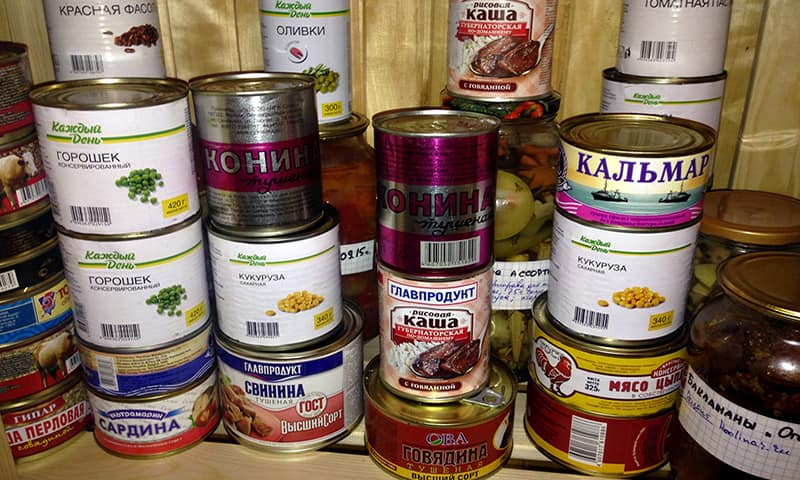
In the future, this list will be expanded with canned soups in glass. Great stuff - dilute it with water 1:1, add a little stew, and boil for 3-5 minutes.
As for canned food. You shouldn’t limit yourself in the assortment. Take what you like to eat into your emergency stock for long-term storage. The more variety, the better.
Go ahead.
Spices
A good set of spices is a must! We'll look at this in detail next time. At the moment I have added the following to the NZ:
- Granulated garlic – 10 packs.
- Dried basil – 4 packs.
- Ground sweet pepper – 4 packs.
- Herbal mixture – 1 pack.
- Frying onions and carrots – 1 pack.
- Bay leaf – 1 pack.
- Yeast - 3 packs.
- Salt – 1 kg.
- Sugar – 5 kg.
Here we will add packaged, so-called “dried soups”:
- Vermicelli soup (different flavors) – 8 packs.
- Pea soup – 2 packs.
- Kharcho – 1 pack.
You can't do without instant noodles. Yes, yes, those same beach packages. Firstly, they can be sharpened dry, and secondly, they are an excellent option for a quick snack. Well, the combination of calories/weight/price.
- 10 packs of different manufacturers, different sizes, different tastes.
- 7 pieces of “hot mug” soups of different flavors and manufacturers.
Let's add some more:
- Kissel – 2 packs.
- Soy meat – 4 packs.
- Crispbread – 4 packs. Quite a high-calorie product. For 100 gr. The calorie content of the product is higher than that of stewed meat.
- Sunflower oil – 3 liters.
- Vinegar 9% - 1 liter. It’s good to have a couple more bottles of 70% vinegar essence.
Cereals:
- Pearl barley – 1 kg.
- Peas – 1 kg.
- Buckwheat – 3 kg.
- Rice – 3 kg.
- Flour – 4 kg.
- Vermicelli – 0.5 kg.
- Pasta – 5 kg.
- Mustard powder – 250 gr.
- Potato starch – 250 gr.
- Breadcrumbs – 250 gr.
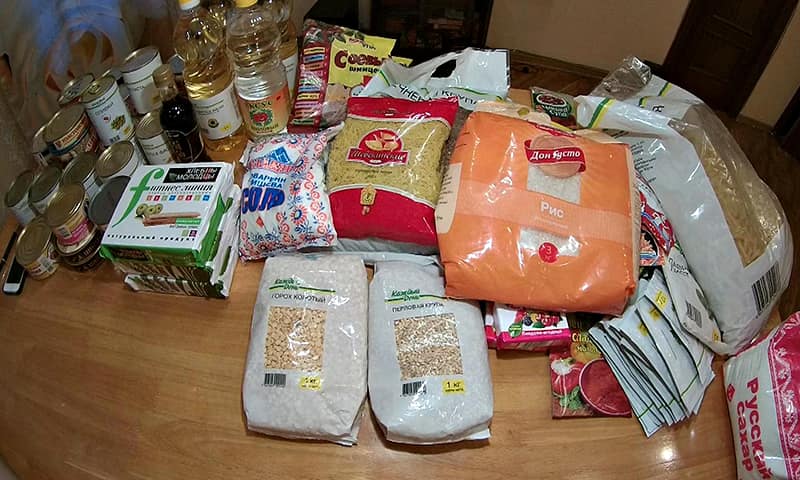
That's all. Let's move on to corking and storage.
Capping and storage
First you need to make a list of all products with expiration dates. 3-4 months before the expiration date, we take out and use the products. We replenish with similar ones. This way there will be a rotation.
It has been experimentally found that, on average, a kilogram of cereal fills almost a 1.5 liter plastic bottle. 2 kg of flour completely fills a 3 liter jar. Pasta - depending on its size and shape.
We will pack emergency supplies for long-term storage in two types of containers: glass jars and plastic bottles. Preparing containers:
- glass jars and their lids. I prefer it as a couple. Place a wire rack on the pan, and jars and lids on the rack with the neck down. Boil for about 30 minutes. It is better to use cans for seaming.
- the plastic bottles , dry them, pour in a teaspoon of alcohol (not vodka!!!), shake and pour into the next one, dry again. You can use bottles from any drinks, milk, etc. But I recommend buying zero-grade bottles with intact ring caps at your nearest beer store. They are not expensive (a liter is 3 rubles). It’s enough to simply alcoholize them. For large volumes, use 5-6 liter water bottles.
Heat the cereals in the oven at a temperature of 100-120°C for 30 minutes, stirring occasionally. Many people suggest heating it in the microwave. I don't recommend it! The integrity of the cereal is compromised. There is an opinion about preparing cereals in the freezer. But not all the bastards die from the cold. Because oven or frying pan.
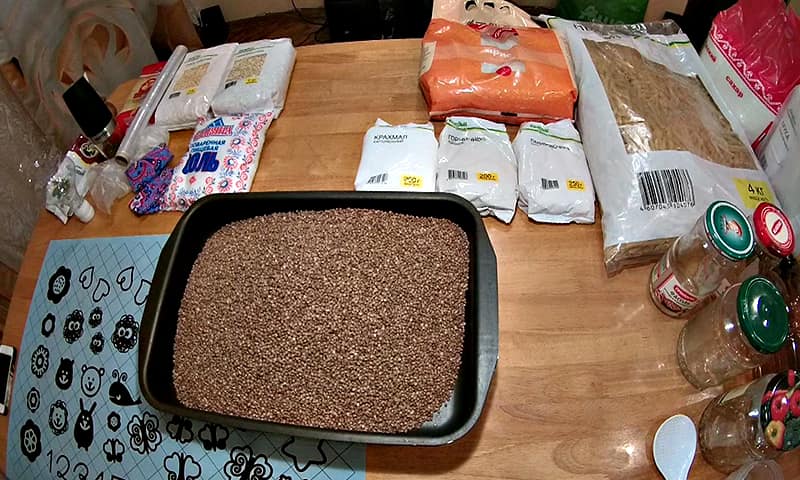
At the bottom of the container we throw a tablespoon of salt, about 5 black peppercorns and a couple of laurel leaves. Add 1-2 cloves of garlic. Not cut, not peeled - otherwise it will rot. Add the slightly cooled cereal. You can also sprinkle salt on top, but I do it differently. We form a small fabric bag with a couple of tablespoons of salt, tie or sew it up and put it on top in a container.
We simply roll up glass jars. Before closing, you can throw a couple of burning matches into the plastic to burn out the oxygen, and screw them tightly while they burn. Don't burn the plastic!
It’s the same with flour, but we heat it at 50°C. We also roll it into jars.
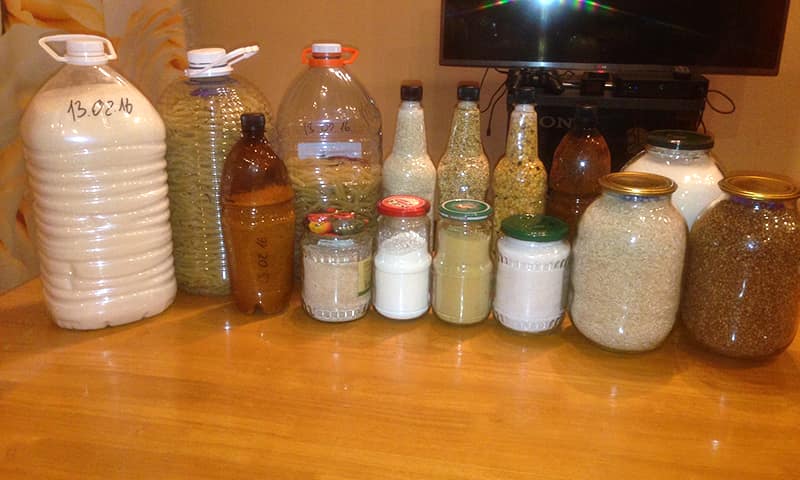
We seal the lids, for example, with paraffin from a burning candle. We place everything in black opaque bags (from light), label it and put it away for storage.
I have a pantry without windows and with ventilation. That's why I don't bother too much.
If you live in a private house, there is a possibility of rats eating plastic. We place the bottles either in an iron container - a barrel, or in a box lined with a fine metal mesh, or simply hang them from the ceiling.
The entire process is presented in more detail in the video below.
In the following releases:
- Additional Products
- Spices
- Hygiene products
- Consumables (from candles to batteries, etc.)
- Medicines
- Drinks (alcoholic and non-alcoholic)
- Items for exchange
- Means of communication
- Seeds
And so on.
Survival everyone.
Author - AntrAx777
How to make a portable emergency supply
A portable emergency reserve is included in the equipment of pilots, cosmonauts, and as part of the configuration of sea rescue equipment. The composition of each NAZ depends on a number of factors that cannot be ignored when completing the set.
The emergency supply is formed depending on the conditions of the planned location, air temperature, duration of travel, and terrain features. It would be nice to have several NAZs at once, placed in your hand luggage, wallet, around your neck, in your pocket, etc. - just in case.
To make NAZ with your own hands, you need to focus on sealing some items using:
- medical dropper;
- several disposable syringes from 5 to 25 ml;
- plastic bags with a zipper;
- large paraffin candle;
- toothpicks;
- lighters;
- knife
Guide to action:
- Cut a piece of tube from the dropper, heat one end over the flame of a lighter and seal it with a knife. Fill a compact container with pepper, salt, manganese and other items. Then solder the other end.
- Fill the syringe with paraffin to a 2 mm mark and push it with the piston (the paraffin should fill the nose of the syringe). After hardening, place cotton wool for tinder in an improvised container, line it with dry cotton wool and plug it with a rubber piston. Fill a large syringe completely with paraffin, which can be easily removed when heated.
- For the main packaging, use a plastic container or a tin tea box with a lock. For greater reliability, wrap it with reinforced tape.
- Place caramels, dates, a few pieces of chocolate, etc. in small plastic zip bags.
Arrange items according to the principle: large items are at the bottom, small items are compactly placed in free spaces.
Reserve for pilots
The pilot's portable emergency supply is carefully designed and selected. There are no random items here - many are multifunctional. For example, a Taiga knife can be used as an ax, machete, knife, shovel, wrench, ruler. And in some modifications - as a butt for a weapon.
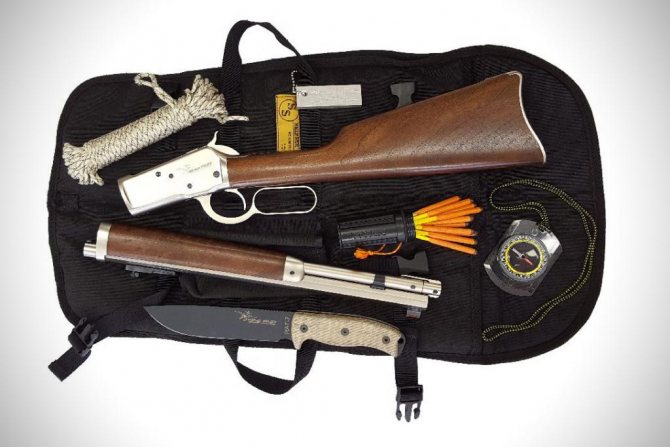
Also, pilots' NAZ includes a small amount of high-calorie food and water. Be sure to have a means of starting a fire (special matches) and a means of giving a signal - a flare gun and a smoke bomb. And of course, it can’t do without weapons.



